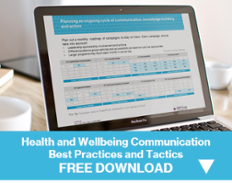A healthy workforce is good for business, but the key ingredient is explaining various benefit programs or resources with clarity, storytelling, visual aids and even humor.
When employers provide the support that employees need to manage their physical, financial, emotional and social wellbeing, they’re able to improve health outcomes and business results in a more meaningful way than traditional health and wellness initiatives. This holistic approach recognizes that helping employees optimize their wellbeing is better for them while also enabling a clear competitive advantage for the organization.
But none of these efforts will bear fruit without year-round communication and involvement activities―and the right pacing, according to Elizabeth Byerly, product development director, communication, The HR Trove by Willis Towers Watson.
To start, she recommends employers examine spikes in claims or other data (e.g., EAP usage, health claims, 401(k) savings) associated with wellbeing topics or goals, and create a communication and involvement calendar that provides employees information when it’s most relevant. This will help avoid overloading the workforce with too much information, particularly around benefits enrollment time, she observes.
“Open enrollment should be a time when you’re giving information to help them make confident benefit purchasing decisions, as well as the company’s goals and aspirations for employees and their families in terms of their wellbeing,” Byerly says. “You’re not asking them to do all those wellbeing activities at that moment when they’re trying to get the enrollment done.”
Power of heads, hands and hearts to engage
There are several key elements of success, beginning with a multi-faceted, year-long communication strategy. It’s imperative this strategy is grounded with clear and concise content, compelling visuals, multi-media, such as video, and storytelling.
For example, a 30-second video can convey three key points of the employers’ mission or benefit plan, a series of posters can tackle each of those areas independently, four pages of printed material can offer more detailed insight, while lunch ‘n learns featuring an employee’s achievements or struggles will help make any messaging more relevant to the entire workforce.
“We love seeing and hearing about how someone else achieved success or where they struggled, what went wrong, what’s motivating them,” Byerly says. “It’s so much more powerful and authentic than reading about a program in a brochure. It grabs your heart for them and for yourself.”
In terms of video, she cites as an example scores of “how-to” videos on the Web that convey ideas visually and immediately through storytelling, metaphors and action. She says “the undeniable power of this medium is messaging with movement and an interactive quality that mirrors contemporary life.”
The human mind absorbs messages easier through multiple senses, Byerly explains, while using more than just one area of the brain “makes it more memorable. Video, or a series of videos, is effective because it’s engaging all of us vs. just a small portion of us.” However, Byerly cautions that the effectiveness depends on the level of detail employers are trying to convey in one video.
While some employers have concerns about the accessibility of videos, mobile internet and apps have made video easily accessible, Byerly observes. Whereas a decade ago when it was anyone’s guess whether employees had the right equipment to view corporate videos in VHS or DVD formats, smartphones and streaming video remove those obstacles. They also put compelling information into people’s pockets to view during a commute on public transportation or any time of the day or night, she says.
Thoughtful Strategy and Content
The chief objective is to be thoughtful about content across materials and activities. “Messaging simplistically with words on a diet but still getting the exact meaning across takes a lot more time than just dumping all the information into a couple pieces,” she explains.
Another valuable tool is the use of humor where appropriate. A funny anecdote about cooking a healthy and delicious dish that turned out to be a kitchen nightmare or outtakes of a video and where it went wrong always will command attention, she notes.
Byerly says stresses that developing―and sticking to―a communication strategy such as she described can help employers convey clarity and simplicity among the complexity of topics, establish or enhance a culture of wellbeing and lead to better employee experiences and engagement. Which of course, can contribute to better results for your organization.
Written by

Bruce Shutan is a Los Angeles freelance writer.
This article originally appeared in EBN's email newsletter, October 10, 2018.



